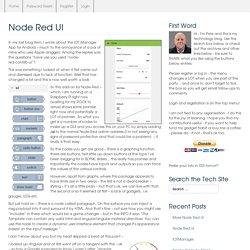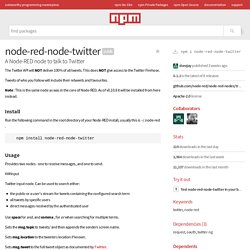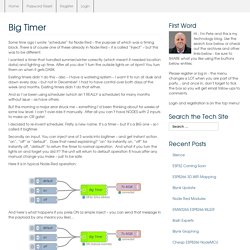

Mqtt node question. Node-RED : norelite.mybluemix.net. Node Red UI. In my last blog item, I wrote about the IOT-Manager App for Android – much to the annoyance of a pal of mine who uses Apple (snigger).

Among the replies was the questions “have use you used “node-red-contrib-ui”? This was something I looked at when it first came out and dismissed due to lack of function. Well that has changed a lot and this is now well worth a look. So this add-on for Node-Red – which I am running on a Raspberry Pi right now (waiting for my ROCK to arrive) shows some promise right now and potentially a LOT of promise. So what you get is a number of nodes to make up a GUI and you access this on your PC by simply adding /ui to the normal Node-Red admin address (I’m not seeing any signs of password protection and that could be a problem) – it really is that easy.
However, apart from graphs, where this package appears to have limits are in two areas – the first is not a deal-breaker – styling – it’s all a little plain – but that’s ok, we can live with that. Node-RED: Lecture 4 – A tour of the core nodes. This lecture will take a look at the core set of nodes that Node-RED installs by default and then show you the extended set of nodes that the cloud-based Node-RED service – FRED – supports.

For each node, you’ll see a brief overview of its functionality and an indication of which example in this lecture series uses the node, so you can look in more detail at how to work with the node. This lecture is mostly a reference section. However, it is worth looking quickly through the nodes, so that you have an idea of the basic functionality available to you as you begin to craft your own flows. When you install Node-RED for yourself on a device such as a Raspberry Pi or Beagleboard, it starts up with a default set of nodes. There are 8 main categories of nodes in the default install: inputs, outputs, functions, social, storage, analysis, advanced and Raspberry Pi (See Figs 4.1 and 4.2) Let’s take a look at each category in turn. Input nodes There are 7 basic input nodes installed by default. Node-red-node-twitter. A Node-RED node to talk to Twitter Node-RED nodes to talk to Twitter.

The Twitter API will NOT deliver 100% of all tweets. This does NOT give access to the Twitter Firehose. Tweets of who you follow will include their retweets and favourites. Note : This is the same node as was in the core of Node-RED. Install. FRED: Front End for Node-RED. PID control Node-RED. Big Timer. Some time ago I wrote “scheduler” for Node-Red – the purpose of which was a timing block.

There is of course one of these already in Node-Red – it is called “Inject” – but this was to be different. I wanted a timer that handled summer/winter correctly (which meant it needed location data) and lighting up time. After all you don’t turn the outside lights on at 6pm!! You turn them on when it gets DARK. Existing timers didn’t do this – also – I have a watering system – I want it to run at dusk and dawn every day – but not in December! And so I’ve been using scheduler (which isn’t REALLY a scheduler) for many months without issue – as have others. But this morning a major error struck me – something I’d been thinking about for weeks at some low level. I decided to re-invent scheduler. Secondly an input. Here it is in typical Node-Red operation: And here’s what happens if you press ON (a simple inject – you can send that message in the payload by any means you like)… Well: And to get it?